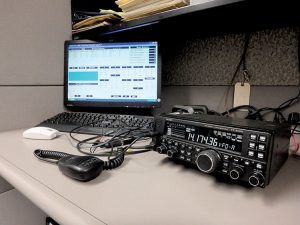THE GARDEN STATE Amateur Radio Association joined thousands of amateur radio operators on the airwaves for the 2016 American Radio Relay League’s Field Day.
Otherwise known as hams, these amateur radio operators are licensed through the FCC and follow strict guidelines in how they operate, the quality of their transmissions and the language used over the air. Specific to the GSARA, club members come from all over Monmouth County, from towns such as Red Bank and Ocean.
Held at the American Red Cross building in Tinton Falls, also the headquarters for W2GSA – the club’s specific call-sign – the 24-hour event was used to showcase capabilities out in the field and in the elements. Field Day began on Saturday, June 25 at 2 p.m. and lasted until 2 p.m. the next day. Club members took shifts working the radios, either during the day or through the night.
Field Day is the busiest day on a ham’s calendar. Hundreds of contacts are made from around the U.S and Canada, along with other hams tuning in from foreign countries, such as South Africa or Italy.
The event is set up like a contest. Clubs receive points throughout the weekend which are tallied up once Field Day has concluded. Points can be accumulated in various ways: by the number of contacts made throughout the weekend, by promoting the event through social media and through usage of ham radios powered by alternative energy sources, to name a few.
No bigger than a 15-inch MacBook, the cell brings in enough power to push frequencies throughout the continental 48 states. “Since we’re only talking the United States, I guess the furthest probably would be Washington State, west coast,” he said.

All in all, Wroblewski’s solar-powered setup fit comfortably on the picnic table behind the warehouse. Adjacent to him, situated on the side yard was another outdoor station collecting contacts.
“My dad was a ham radio operator and he got me interested, so it was kind of natural that I would just fall into it,” said Cy Stanway, a licensed ham radio operator of 41 years.
Stanway appreciated the fortunate weather for this year’s Field Day, as his tent and equipment were almost fully soaked in last year’s event. A steady downpour ended up displacing nearly three inches of water at his feet, which made for a challenging weekend.
“There’s the emergency component and the public service component,” he said. “Field Day is supposed to highlight the emergency component, so you can go out in less than ideal conditions.”
While the weather is hit-or-miss outside, the environment inside is cool and controlled. Positioned beside mountains of stacked water bottles and other disaster relief equipment, the GSARA placed in the Red Cross warehouse. Through a door labeled “Disaster Communications: Authorized Personnel Only” sits a collection of ham radios ready for use at a moment’s notice.
“We operate as an alternate EOC, emergency operations center,” said Howard Suffill, second-year president of GSARA.
Suffill knows a thing or two about working in emergency situations. After upgrading his ham radio license in 2005, he traveled to Jackson County, Mississippi after Hurricane Katrina made landfall. Under his own accord, he drove south in his van to lend a helping hand. “We stayed there for a little over a week and operated,” he said. “Not typically out of my van , I was at an EOC in Jackson County.”














